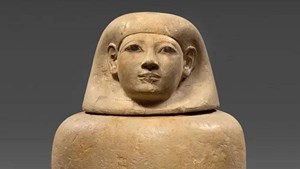
Moesgaard Museum’s new special exhibition about ancient Egypt lifts the lid on a sensational new international discovery. Scientists have, for the very first time, managed to recreate the scent of a 3500-year-old embalming oil. The fragrance originates from the mummification of a high-ranking Egyptian woman who was the wet nurse of Pharaoh Amenhotep II when he was a baby.
A very special sensory experience awaits visitors when Moesgaard Museum opens its new special exhibition on 13th October. The exhibition Ancient Egypt – Obsessed with life will unveil a research breakthrough that enables guests – quite literally – to stick their noses into the past and smell the fragrance of eternal life.
A research team in Germany, led by archaeologist Barbara Huber of the Max Planck Institute, has deciphered and recreated the fragrance of an embalming oil employed during the mummification of an Egyptian woman more than 3500 years ago. The team has analysed a so-called canopic jar in which the embalmed lungs of noblewoman and wet nurse Senetnay were placed around 1450 BC.
The canopic jar, which was found during an excavation in the Valley of the Kings at Luxor more than a century ago, is now kept at the Museum August Kestner in Hannover, Germany. Using advanced analytical methods, the scientists were able to identify the fragrance notes of the embalming oil, even though the contents of the jar had long since disappeared.
Working with a French laboratory, the team was then able to recreate the fragrance which will now be made available to visitors in Moesgaard Museum’s coming exhibition, providing them with a unique opportunity for a remarkable sensory experience of the past.
” We are very pleased to be able to present this completely new research, which has only just been published, in the exhibition. We are particularly looking forward to giving our visitors a sensory experience of the past: The recreated fragrance of an embalming oil used in an Egyptian mummification workshop thousands of years ago. It is a quite unique and special way to make a connection between the past and the present,” says Mads Holst, Director of Moesgaard Museum.
The ancient fragrance, which has been given the English name ’The Scent of Eternity’, will be included as part of the special exhibition, which focuses on the ancient Egyptians’ love of life and conceptions of the afterlife.
While other exhibitions about ancient Egypt often focus on death, Moesgaard Museum’s coming exhibition concentrates on life and provides an insight into Egyptian conceptions of the afterlife and the rituals involved in reaching it. Visitors will be able to follow the full sequence of events from the moment of death, to embalming and mummification, then the journey as a mummy to the tomb, through the underworld and back again into the brilliant sunshine of an eternal existence in the hereafter.
The aim of converting the deceased into a mummy was to transform them into Osiris, god of the afterlife. By interring the mummy deep in the burial chamber of a shaft tomb, the deceased was then able to move from this world into the underworld, avoid annihilation and exist for eternity.
The mummy is, at one and the same time, a person, a god and an artefact that can forge connections between the living and the dead, the person and the universe – a divine object, the creation of which required numerous costly materials and detailed anatomical and ritual knowledge.
The special exhibition, which opens on 13th October, focuses primarily on the Pharaonic Bronze Age from c. 2600-70 BC.
Main Image :

ArtDependence Magazine is an international magazine covering all spheres of contemporary art, as well as modern and classical art.
ArtDependence features the latest art news, highlighting interviews with today’s most influential artists, galleries, curators, collectors, fair directors and individuals at the axis of the arts.
The magazine also covers series of articles and reviews on critical art events, new publications and other foremost happenings in the art world.
If you would like to submit events or editorial content to ArtDependence Magazine, please feel free to reach the magazine via the contact page.